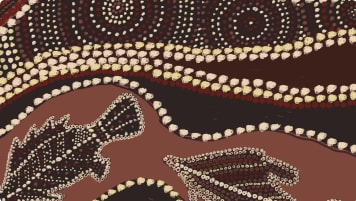Cave Hill, South Australia
Cave Hill, also known as Walinynga in the local language, is the most significant rock art site within Central Australia and was a ceremonial site for Aboriginal people from various regions. Visited as part of a small group tour for senior couples and solo travellers.
27 Feb 21 · 6 mins read
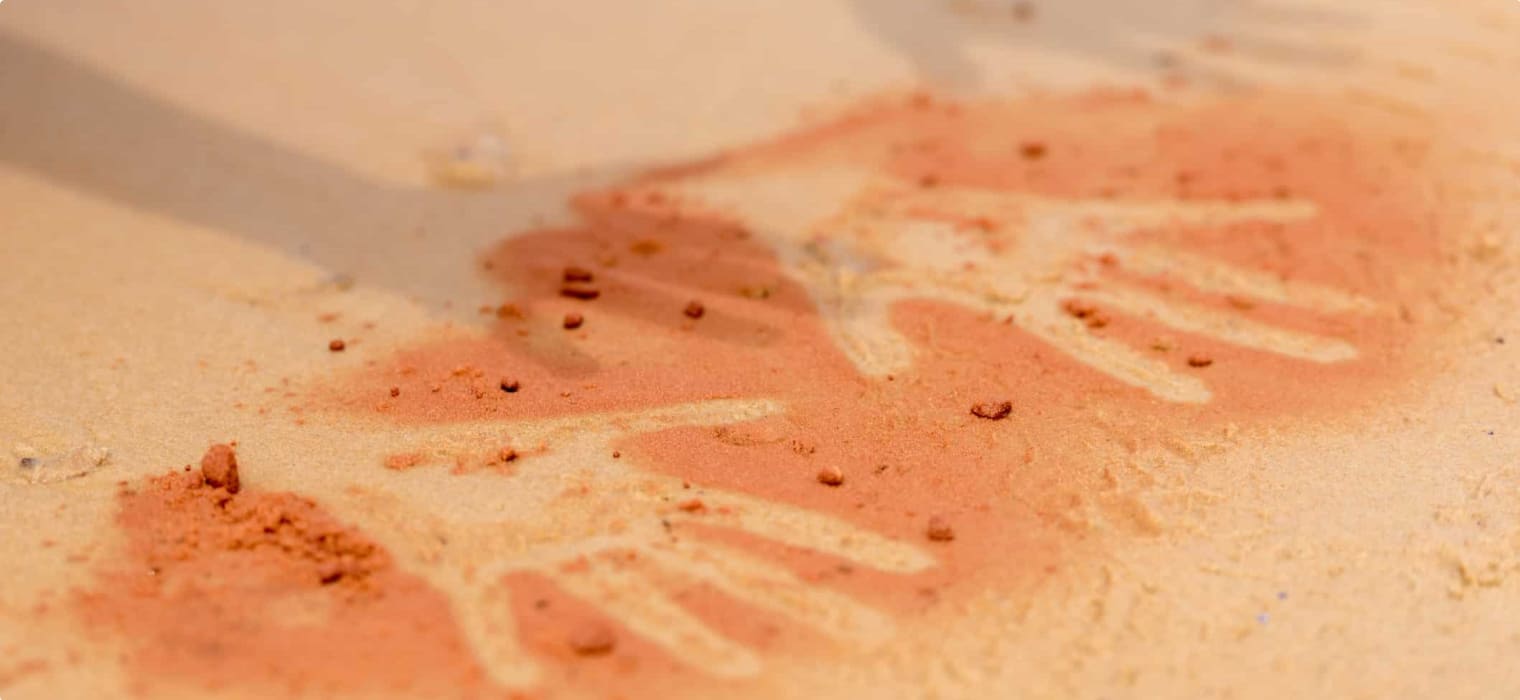
Cave Hill: Rock Art & the Seven Sisters Creation Story
Cave Hill, also known as Walinynga in the local language, is the most significant rock art site within Central Australia and was a ceremonial site for Aboriginal people from various regions. The natural monument is in Pitjantjatjara territory in the imposing Musgrave Ranges, north-west South Australia, 40 km from the Northern Territory border and around 100km south of Uluru (Ayers Rock). It is the only known rock art site for the Seven Sisters Songlines and also features magnificent cave paintings depicting the Perentie and Honey Ant Songlines that traverse the Anangu Pitjantjatjara Yankunytjatjara (APY) Lands.
This article explores the artwork at Cave Hill and the story of the Seven Sisters. Information is sourced from Margo Neale & Lynne Kelly’s book Songlines: The Power and Promise, as well as sources linked to throughout the article. It is part of a continuing series of pieces on art, culture, ancient landscapes, and Aboriginal lands of Australia. As part of our commitment to understanding and sharing our knowledge of the history, culture and landscapes of Australia it is recognised that an appreciation of indigenous activity is an important facet of learning on our tours. These tours are for both the mature and senior traveller, as part of a couple or as a solo traveller.
The Cave Hill Artwork
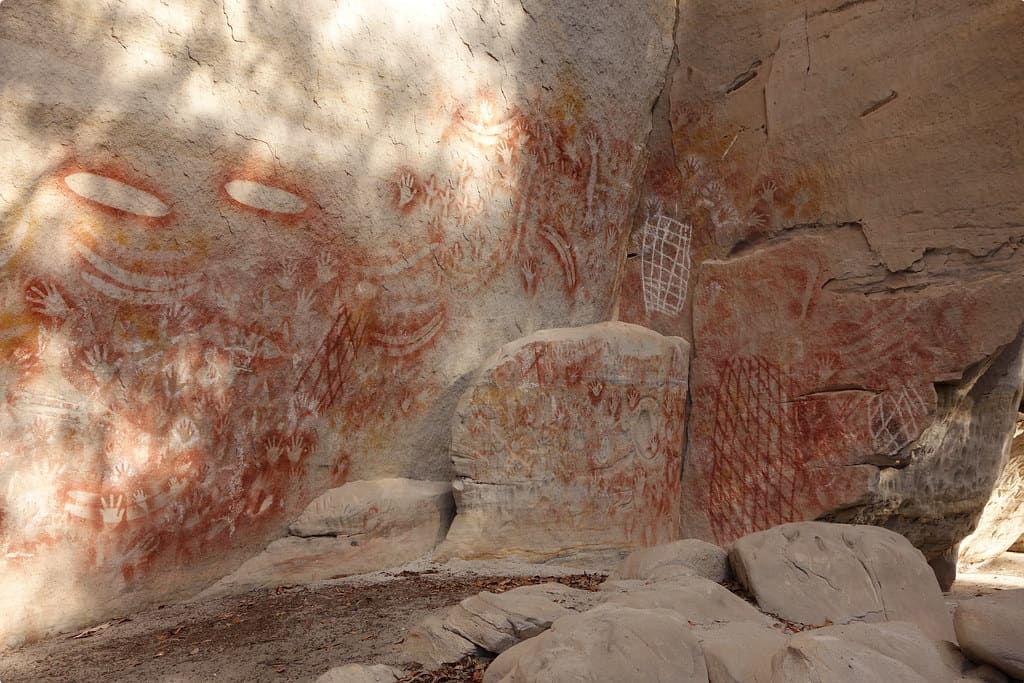
On the roof of the cave are many paintings with images that include abstract designs, numerous human figures, and a host of animals, both native and introduced ones such as horses and camels. The appearance of these introduced species reveals the continued process of rock painting and Indigenous adaptability to the knowledge that came with the colonisation and contact with other cultures. The oldest paintings, now largely faded, date back 24,000 years and feature alongside colourful ones of red, yellow and white ochre done as recently as 1974.
Some paintings have been done over the top of each other. Australian academic Lynne Kelly writes in Songlines: The Power and Promise that “Aboriginal rock art isn’t simple, unchanged or static”. She explains that “artists sometimes superimpose new paintings over old as part of ceremony” in an act of “revitalisation, respect and renewed engagement”.
Here, the most recent artwork has been painted over a series of older concentric circles and tracks. It was not done for the purpose of renewal, however, but to obscure them from outsiders and the uninitiated as the symbols could be too powerful and dangerous for them. This demonstrates the cultural sensitivity about vulnerable people being exposed to restricted knowledge.
The Seven Sisters Creation Story
Cave Hill is the only rock art site of its kind that tells the Dreamtime creation story of the Seven Sisters. This story relates to the journey of the seven sisters that make up the group of stars we call the Pleiades, in the constellation Taurus. Similar myths appear in countless other cultures, from the Greeks to the India, Chinese, Persians, Scandinavians, Native Americans, Egyptians and Polynesians – anywhere really where people could look up at the stars and wonder the mysteries of the universe.

Not surprisingly then, it is one of the most widely distributed ancient stories amongst Aboriginal cultures. The Songlines for this story extend over more than half the width of the continent, travelling from the gulf country of Queensland, down through the Northern Territory to South Australia, through Cave Hill until it reaches the Great Australian Bight.
An Australian Songline is an Aboriginal voice map of Country, a route that covers the pathways travelled by the ancestral spirits of the Dreaming (creation time) as they created the land and all natural phenomena. The creation stories as well as practical knowledge needed for survival and navigation of the land are recorded in traditional music and art, which are passed down generation to generation ceremoniously at important sites and locations along the paths.
Generally, the Seven Sisters story tells of an Ancestral being in the guise of a man who relentlessly pursues seven sisters (Ancestral Women) over the land. Under traditional law, the man pursuing the sisters is the wrong skin group and forbidden to take them as wives, so they are seen to be running away. In an attempt to escape, they launch themselves from earth into the night sky, but the man follows suit into the stars. Now every night, we can still witness their ongoing chase, the man travelling in the form of a star seen in the Orion’s Belt cluster after the sisters in the Pleiades.
The story is used as a cautionary tale of troublesome male sexual desire. It tells of the potential danger of unruly arousal not only to women, but to men themselves, their families and society.
The Yankuntijatjara Version of the Seven Sisters Story
Each tribal group retells their own version of the story, with the rock art at Cave Hill portraying the Yankuntijatjara tale. It charts the movement of the man, Wati Nyiru, and the Sisters from the Western Australian desert into South Australia.
The main traditional owner of the site, Stanley Douglas, defends Wati Nyiru, insisting that he intended to be polite and charming with the Sisters and approach them in the “proper way” when they were trapped in the save. The problem arose when his mapla – his penis, or “special friend” as Douglas politely calls it – became so excited at the possibility of making the sisters his wives.
Wati Nyiru’s malpa grew so long that it needed to be wrapped around his waist, but he soon lost control of it as it took off like a rock in pursuit of the Sisters along the Songline. At one stage, that unruly member struct the rock at Cave Hill and created a long groove that can be still be seen.
The Sisters eluded him yet again, escaping through an opening at the back of the save. Outside they danced and fled, with Wati Nyiru in pursuit. So the saga continued onto further sites, where the features of the land were shaped by the Sisters and their persistent stalker.
Songlines: Tracking the Seven Sisters Exhibition
Cave Rock’s rock paintings have been scanned for the Songlines: Tracking the Seven Sisters exhibition, where they are projected inside an immersive six-metre-wide dome. A circular upholstered platform with head cushions allows viewers to lie down beneath the dome while hearing Aboriginal voices tell the stories of the Seven Sisters along with ambient sounds of Country.
This is just one part of the exhibition previously on show at the National Museum of Australia and now touring nationally and internationally. The exhibition takes visitors on a journey along the Seven Sisters Songlines through paintings, sculptures, ceramics and state of the art multimedia, representing more than 100 artists.
Stories originally performed on Country are shared in new ways, with artworks becoming portals to the deserts of the Martu, the Ngaanyatjarra and the APY peoples. Visitors walk past a sequence of paintings as if they are walking past a sequence of sites along the Songlines, mapped across 1000 square metres. As they go along, they acquire knowledge as real initiates do, travelling the Songlines and being taught by elders who guide their journey.
The project leading to this exhibition was initiated by Aboriginal elders who wanted to preserve the Seven Sisters stories for future generations and custodians, while promoting a broader understanding of Songlines. The elders hope that those who engage with the exhibition will develop a sense of co-ownership and feel some responsibility to preserve the Songlines as part of Australia’s natural and cultural heritage.
Tour of Aboriginal Australia

Travellers with an interest in learning more about the Aboriginal heritage of Australia may want to check out our various outback Australia tours.
These include visits to:
- Archaeological sites including the Madjedbebe rockshelter and the extensive collection of ancient Aboriginal rock art at Kakadu National Park as part of our tour of Kakadu and Darwin
- The ancient indigenous sites including Lake Mungo and the Budj Bim Cultural Landscape as part of our tour of the Southern States of Australia;
- The important cultural site of Wilpena Pound on our tour of the Flinders Ranges;
- The ancient rock art in the Kimberley, Western Australia;
- The Brewarrina Fish Traps in outback Queensland;
- Uluru and Kata Tjuta in the Northern territory.
Every Odyssey guided tour is designed especially for mature and senior travellers, who want an authentic and informed experience of their destinations. Our tours aren’t the typical tourism Australia holiday – Blue Mountains, the Great Barrier Reef, and the penguin parade on Port Phillip Island. Instead, we pride ourselves on getting of the beaten path and making you think about Australia and New Zealand in new ways. We move in genuinely small groups – usually 6-12 per tour – and all tours are cost-inclusive, encompassing accommodation, attraction entries, and transport. For more information, click here, and head to this page to make a booking.
Articles about Australia published by Odyssey Traveller:
- Uncovering the Ancient History of Aboriginal Australia
- Aboriginal History and Culture of Kakadu National Park
- Aboriginal Land Use in the Mallee
- Understanding Aboriginal Aquaculture
- The Kimberley: A Definitive Guide
External articles to assist you on your visit to Australia:
- The Story of Aboriginal Art
- Indigenous songlines: a beautiful way to think about the confluence of story and time
- The Dreaming
- Meaning of land to Aboriginal People
- Aboriginal History
We acknowledge Aboriginal and Torres Strait Islander peoples as the First Australians and Traditional Custodians of the lands where we live, learn and work. We pay our respects to Elders past, present and emerging.
Related Tours

days
Apr, May, Jun, Jul, Aug +3Small group tour exploring Alice Springs and Uluru-Kata Tjuta National Park
Visiting Northern Territory
Explore and learn about historic Alice Springs, The MacDonnell ranges, and Uluru-Kata Tjuta National Park. This escorted small group tour for mature and senior travellers, travelling as a couple or solo travellers also visits the Hermannsburg Lutheran mission plus Henbury meteorite site learning about the Aboriginal outback and contemporary art.

days
Apr, Jun, Aug, Nov, Mar +2Exploring Alice Springs and Uluru-Kata Tjuta National park by Motorbike
Visiting
Explore on a Motorbike tour in the Outback and learn about historic Alice Springs, The MacDonnell ranges, and Uluru-Kata Tjuta national park. This escorted small group Motorbike tour for mature and senior travellers, travelling as a couple or solo travellers also visits the Hermannsburg Lutheran mission plus Henbury meteorite site learning about the Aboriginal outback and contemporary art.

days
Jun, Jul, Sep, Feb, Mar +1Darwin and Kakadu small group tour
Visiting Northern Territory
Explore and learn as part of a small group tour for seniors on this package tour to Darwin and Kakadu National park, a UNESCO world heritage site. This program also visits Arnhem land. Our focus is on ecology, landscapes and history on this 14 day program in the far north of the Northern Territory.

days
Mar, May, Aug, Sep, Oct +2Small group tour of World Heritage sites and more in the Southern States of Australia
Visiting New South Wales, South Australia
Discover the World Heritage Sites of the southern states of Australia travelling in a small group tour. A journey of learning around the southern edges of the Murray Darling basin and up to the upper southern part of this complex river basin north of Mildura. We start and end in Adelaide, stopping in Broken Hill, Mungo National Park and other significant locations.
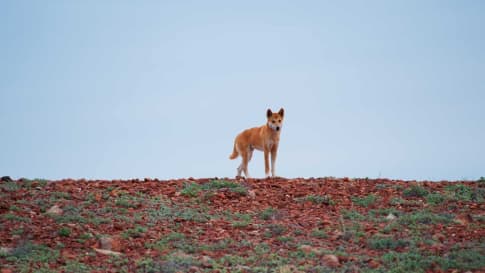
days
Apr, May, Jul, Aug, Oct +2Small group tour of Australia's Flinders ranges
Visiting South Australia
Escorted small group tour of the Flinders range in South Australia from Adelaide. Learn about Coober Pedy, Wilpena pound and water system of Lake Eyre as we explore and learn also about the history of the people who explored the Flinders.

13 days
May, Jun, Jul, Aug, SepSmall group tour of Australia's Kimberley
Visiting Western Australia
Escorted small group tour of the Kimberley. We explore and visit The Bungles, Bell Gorge, Mitchell plateau & Halls Creek in the dry season. Amazing landscapes intertwined with Aboriginal communities resident more than 45,000 years.
From A$15,390 AUD
View Tour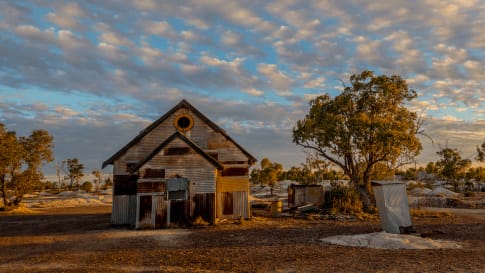
days
Mar, Apr, May, Jul, Aug +2Small group tour of outback Queensland
Visiting New South Wales, Queensland
To Dubbo and back, this small group tour takes you to learn about the Brewarrina fish traps, we travel high up into North Queensland to see the Dinosaurs of Winton and incredible Aboriginal rock art at Cathedral gorge and learn about opal mining and the history of Lightning ridge.
